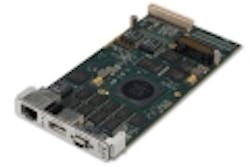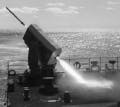ADS-B In brings air traffic management to pilots in the cockpit
Air traffic control (ATC) radar -- the primary tool for air traffic management in the United States -- will be replaced over the next decade by satellite-based navigation system called Automatic Dependent Surveillance–Broadcast (ADS-B). The radar systems themselves will still be available as backup for air traffic controllers, but the U.S. Federal Aviation Administration (FAA) in Washington requires aircraft flying in controlled airspace by 2020 to broadcast their positions though ADS-B.
“This rule gives the green light for manufacturers to begin building the onboard equipment that will allow our air traffic controllers to know where aircraft are with greater precision and reliability,” says FAA Administrator Randy Babbitt. “That is one of the key elements of NextGen that will improve the safety and efficiency of flight.” For more on ADS-B, see related story FAA clears ITT-deployed ADS-B system for nationwide rollout.
ADS-B avionics essentially will enable the aircraft to monitor its position in relation to other aircraft more accurately than they can today by using satellite navigation through the Global Positioning System (GPS), says Adam Evanschwartz, principal marketing manager of commercial systems at Rockwell Collins in Cedar Rapids, Iowa.
What is ADS-B?
ADS-B has many applications but its main purpose is to enable an aircraft to determine its position using satellite navigation and then broadcast the position -- along with its altitude, speed, heading, call sign, and aircraft type -- automatically to other aircraft and to air traffic control.
By 2020, the FAA will require ADS-B Out equipment for aircraft flying in airspace including Classes A, B and C, around busy airports and above 10,000 feet. The nationwide rollout of ADS-B ground stations will be complete in 2013.
ADS-B Out is the information broadcast by the aircraft to ground control stations, which then relay the aircraft position data via radios from ITT Corp. in White Plains, N.Y., to air traffic control stations. This technology was already being implemented by ITT on the ground.
The ADS-B information is broadcast on the 1090 megahertz spectrum and is compatible with the transponders used for traffic alert and collision avoidance systems (TCAS), Stone says. For the general aviation community, the ADS-B data link is 978 MHz, often called the Universal Access Transceiver (UAT) link.
ADS-B In
Where pilots will see the most improvements is with ADS-B In, which refers to the reception by aircraft of ADS-B data. ADS-B In is in contrast with ADS-B Out, which is the broadcast by aircraft of ADS-B data. ADS-B In will enable flight crews to view the airspace around them in real-time.
ADS-B In essentially will reduce the workload for controllers and the flight crew, explains Cyro Stone, the ADS-B/SafeRoute programs director at Aviation communication & Surveillance Systems (ACSS) in Phoenix, a joint venture company of L-3 Communications & Thales. It brings greater situational awareness to pilots than they have today by providing traffic information to the pilot’s display updated continuously in real-time -- whether on a primary flight display or an electronic flight bag (EFB). “It does not eliminate the need for air traffic controllers,” Stone emphasizes.
Among the advantages of ADS-B In is helping to reduce aircraft fuel consumption and noise by enabling continuous-descent approaches, as opposed to the traditional stair-step downward approach to airports that aircraft take today, Stone says. During a stair-step approach to landing, aircraft alternately descend, and then level off by accelerating engine speed, which wastes aviation fuel and creates more noise.
Air traffic control typically directs non-ADS-B aircraft to level out periodically so they can maintain their positions relative to other aircraft, Stone continues. With ADS-B In technology the flight crew can see their aircraft's position on their cockpit displays continually in relation to other aircraft, and can maintain separation without air traffic control assistance during continuous descents. This also will help reduce vectoring problems at airports, Stone adds.
ADS-B In displays
Standards for displaying ADS-B In information on cockpit avionics or EFB are still being formulated, and as a result, companies designing ADS-B In solutions take different approaches, says Chad Cundiff, vice president of crew interface systems at Honeywell Aerospace in Phoenix. As of yet there is not an ADS-B In mandate from the FAA as there is for ADS-B Out, says Rockwell Collins's Evanschwartz.
One of the things yet be determined is how to represent aircraft of different sizes and performance profiles on the cockpit display, Cundiff says. Each pilot also might have different preferences for how he much information he wants displayed on the screen, Evanschwartz says. Some operators may want to use EFBs for surface area moving map applications to keep the pilot’s eyes focused on the forward field of view, he adds.
Each company is testing its receivers, transponders, data processing software, and avionics displays with airlines and airframers to see what will work and what the pilots themselves feel will be most efficient.
ACSS and SafeRoute
The first commercial certification of ADS-B In technology involved cargo carrier United Parcel Service (UPS) and SafeRoute software tools from ACSS, Stone says. They integrated SafeRoute on six Boeing 757s and five 767s -- using SafeRoute software on EFBs from Astronautics in Milwaukee. "We plan to have the entire fleet [of 211 aircraft] equipped," says Mike Mangeot, a UPS spokesman. UPS has already tested merging and spacing applications as surface area moving maps (SAMM). UPS saved about 250,000 gallons of fuel a year by using ADS-B In, reduced engine emissions by 30 percent, and cut noise by 34 percent, Stone says.
ACSS upgrades to ADS-B In involves "a software update in the TCAS box," Stone explains. "Then it becomes surveillance processor and receives ADS-B data." Sensor data then appears on the cockpit display of traffic information (CDTI), Stone continues. This can be done on EFBs or on the primary cockpit displays, but EFBs are more cost-effective, he says.
The CDTI involves the moving map, while he actual processing is performed back in the TCAS processor, he adds. It is not expensive to upgrade an aircraft, Stone says. The upgrade typically involves wiring to the aircraft GPS and cockpit display.
Product offerings
The TSS-4100 transponder from Rockwell Collins enables ADS-B In by turning the TCAS into an ADS-B In traffic computer, Evanschwartz says. It will be part of is part of the company’s Pro Line Fusion integrated avionics system, he adds. The TSS-4100 transponder receives interrogations from ground and airborne secondary surveillance radars and replies by transponder to interrogation from air traffic controllers or TCAS avionics. The main upgrades for aircraft will be with display software and adding a new wire to connect to the GPS receiver, he says.
The TSS-4100 is packaged in the same box as the TCAS, he says. The traffic computer does not replace TCAS, as it will still be a back-up, Evanschwartz says. Future ADS-B In software applications may enable the pilot to check the nomenclature, position, and flight path of nearby aircraft Evanschwartz says.
Honeywell’s SmartTraffic system enables the newly developed Airbus Airborne Traffic Situational Awareness (ATSAW) system by using ADS-B In technology, Cundiff says. A fuel savings of $100,000 per aircraft is estimated to result from using ATSAW on transoceanic flights, Cundiff notes.
Honeywell’s solution uses ADS-B In Hybrid Surveillance technology to minimize frequency congestion in addition to ADS-B In SmartTraffic technology to improve safety, reduce fuel consumption, and optimize long-haul flights. Honeywell’s system is the only ATSAW offering which does not require new hardware installation, saving airlines more than $25,000 per aircraft. Turkish Airlines selected ATSAW and Honeywell’s SmartTraffic technology on 10 new A330s delivered in 2010 through 2012.
Honeywell also demonstrated transoceanic in-trail procedures with the FAA in 12 United Airlines 747-400s, Cundiff says. These aircraft were equipped with a TPA100B derivative, an electronic flight bag (EFB), and TRA67B transponder.
Most organizations that are running ADS-B In demonstrations are doing them more for technology development rather than a sales pitch, Cundiff continues. For example during the United demonstration, an EFB was used to display ADS-B In information as it was more cost effective for the demonstration, but operators may choose to move it to the forward display based on their specific requirements -- even though it will be more expensive, he continues.


